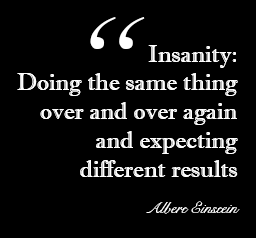The Real 'Cost of Doing Business'
 It’s often said that the definition of insanity is doing the same thing over and over again and expecting a different result. So let me set the scene, and then you tell me if the training shoe fits…
It’s often said that the definition of insanity is doing the same thing over and over again and expecting a different result. So let me set the scene, and then you tell me if the training shoe fits…
In 2008, the global analyst firm IDC published a white paper entitled ‘Counting the Cost of Employee Misunderstanding‘ which examined the financial impact of human error on 400 UK and US businesses with over 5000 employees. The study surmised that human error (defined as actions by employees who have either misunderstood or misinterpreted company policies, business processes or job functions); cost companies an estimated $37 billion every year. The further cost of damage to intangibles such brand reputation, trust and customer loyalty only extrapolate the consequences.
So by exposing human errors as one of the biggest drains on company profits and resources, you’d assume that this data must have caused quite a stir in the training and development community. Surely this preventable waste spurred a training revolution, given the bold-faced evidence that what we’re doing isn’t working. You’d think so, right?
WRONG!
Flash forward 6 years since the release of the IDC report, and what have most companies done about their approach to training? Zip, zilch, nada, zero! Most continue to blast their employees with one-size-fits-all content and deliver that content through large, heavy classroom style sessions, or through dry LMS scenario-based presentations. Even though we have the data that says, “what we’re doing isn’t working”, corporations are still reluctant to change the way they deliver their training. Or, maybe they just don’t know that there are alternatives?
In 2011, Cisco published the “Connected World Technology Report” and reported that 70% of young professionals surveyed admitted to violating company security policy, and 80% think restrictions on use of social media while at work are archaic. Others stated that they were completely unaware of any corporate policies around such matters. Yet according to the 2013 “Towards Maturity Benchmark Report”, 93% of learning and development departments feel they effectively communicate corporate policies. Symantec’s 2013 “Ponemon Cost of a Data Breach Report” found that two-thirds of all data breaches are the result of human error, costing organizations an average of $332 million in brand value in the year following that breach.
So, I ask you. With all of this data pointing to the huge related losses, how does human error continue to fly below the corporate radar? Why aren’t we screaming “revolution!” from the rooftops (or corner offices)? By ignoring the issue, companies are only putting themselves at risk for compliance, safety and legal issues…again…and again…and again.
To try and understand why, we need to look at the of apathy bubble we’ve created around what to expect from human capital. To err is human right? We pacify ourselves with turns of phrase like “that’s just the cost of doing business” or “every mistake is a stepping stone”. Companies are guilty of committing mass-complacency on a global scale—but it doesn’t have to be that way! It’s time to say goodbye to status quo forever and embrace the future of training. No more excuses!
New approaches to learning which combine the latest advancements in brain science with adaptive learning technology and gamification, offer organizations a new way to think about, develop, and deliver training – and early adopters are already seeing a huge return on their training ROI.
When PepBoys, a two billion dollar automotive aftermarket retailer in the US, transitioned from their manager-led training model, to a daily dose of bite-sized, highly targeted, highly personalized content, they saw their shrink rates reduced by 55%. Similarly, Walmart Logistics saw a 54% decrease in incident reports, and a Lost Times reduction of 50% during their first 6 months using the same model.
By adapting the training process to how employees actually learn, managers can quickly align employee performance with operational benchmarks. Sophisticated analytics allow managers to track participation and success rates, providing clear insight into what their employees know…and what they don’t—paving the way for proactive and preventative coaching. Implementing an engaging training program that reinforces smaller, more relevant chunks of content, maximizes knowledge retention, reduces error, and continually improves employee effectiveness.
In today’s competitive market, those companies that realize we don’t have to accept the status quo, and embrace technologies that actually work in a way that optimizes our infinite capacity to learn, will be positioned to outmaneuver, outperform and outsell their competition—one employee at a time.
So, back to my first question…
When you think about your organization’s approach to training—does the shoe fit?
Written by Sabrina Prudham